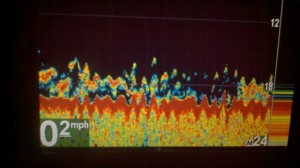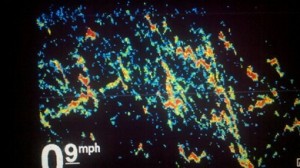Finding a good place to fish is the most challenging and important aspect of any fishing trip. The best gear and most effective baits won't catch a thing if there are no fish in the area you are fishing. Therefore it's important to develop a strategy for finding productive waters.
Entire books have been written on how to find striped bass. There's no doubt that moon phases, tides, weather patterns etc. all have some sort of impact on where striped bass go. Unfortunately, where I fish in Cape Cod Bay, despite my earnest efforts, I've never been able to accurately predict where the bass will be based on any sort of variable.
Take what occurred to me this past week as an example. As I write this, it is the middle of September and we've had a week of sustained easterly winds. This past Saturday the wind died down to the point that it was flat calm. We headed out on the water, found fish in 20 feet of water off Sandy Neck, and stuck with them as they moved up tight to the beach. It was a great night on the water, as we caught over 30 keepers up to 42 pounds.

Two days later the same exact weather pattern occurred again. An easterly wind died down as evening approached. The weather was literally exactly the same as during the productive trip of two nights ago. Moon phases and tides were spot on, and I had high hopes for a repeat of the previous trip. We found bass in the same spot in 20 feet of water off Sandy Neck. Unfortunately the fish disappeared, and did not move up shallow. I searched around for 3 hours without marking a thing. We went home having caught one fish-completely puzzled as to where the fish had gone.
My point is that despite the best strategy, log book, and electronics, I am often completely "bam-boozled" by striped bass. As soon as I think I have them figured out, they throw me for a loop and bring me back down to Earth.
Keeping all of this in mind, it is very possible to develop a strategy that will consistently give you a great chance at finding striped bass. With a sound game plan, you may not always find the fish, but you will certainly put yourself in a great position for having a productive trip.
How to use Sonar to Locate Striped Bass
Having a reliable, properly installed, color sonar unit is an absolute must for the search strategy that I typically employ. Usually there are no surface indicators (breaking stripers, diving birds etc.) leading me to the bass, therefore I needed to develop a strategy using my electronics to help me locate the bass that I knew were out there, somewhere, in Cape Cod Bay.
I also needed a strategy that would allow me to cover vast expanses of water very quickly, so it would be very important that my sonar work flawlessly at speeds above 20 mph. Cape Cod Bay is a massive body of water. The bass could really be just about anywhere.
Even if you fish in areas with structure or current, where bass are not spread out across vast distances, using some of the guidelines described below will still help you locate more fish using your sonar.
Before Starting the Search
Before I begin cruising around, I consider a few variables that I deem pretty important when it comes to finding stripers. The first variable is the time of the year, the second is the time of the day, and the third is where I found the bass last time I went fishing.
As I mentioned before, variables such as tide, moon phase, and weather conditions are certainly important, however where I fish in Cape Cod Bay, I've found that the time of the year, the time of the day, and where I found fish the last time I was on the water, are the three most important factors in developing an initial search pattern.

So let’s say it is late August on Cape Cod Bay. I went fishing a couple days ago and found a reasonable amount of bass around sunset in 25 feet of water, spread throughout a mile long section of beachfront. During that trip, the biomass of bass gradually moved out deeper as it got darker-all the way out to 70 feet of water.
I encountered this scenario quite a few times during the summer of 2011. This is also pretty typical of how bass often behave during late August in the Bay.
Starting the Search
So based on my past experiences of how bass generally behave during late August, around sunset, I would begin my search in 25 feet of water. I'd cruise down the beach at 20 mph, keeping an eye on the sonar as I go.
For the moment, I'd avoid spending time investigating shallower or deeper water, and trust that the bass will again exhibit the same behavioral pattern as the last time I was out on the water. There's no need to mix things up just yet, until we have established that the bass have, for whatever reason, entered into a different behavioral pattern.
Often times I will cover miles upon miles of beachfront without marking a single fish. I'll try to not get hung up on past GPS waypoints, and instead trust that if I continue to eliminate miles of water, I will eventually stumble upon some life.
If you really think about, marking even just one school, or in some cases one single bass, is quite an accomplishment. There are miles upon miles of open water out there.
Fortunately for us fishermen, bass tend to hang in large schools. Even big schools of hundreds of bass are often just a small part of an even larger biomass of thousands of fish. If you stumble upon one school of bass, then that is great news. Odds are that school is a small part of a much larger biomass of fish, spread throughout the general area.
My most productive trips are the ones in which the bass exhibit the same behavioral patterns, in the same area, as the last time I was out on the water. It is obviously much easier to find and catch bass when they fall into a “predictable’ routine.
For example, I remember a trip this past season when we found bass in 25 feet of water just as the sun was setting. I put my bet on the bass slowly moving out into deeper water as it got darker, and fortunately I bet right. We were able to stay with the bass the entire trip, catching fish up to 40 pounds and having a blast.
On the other hand, a week later I again found bass in 25 feet of water just before sunset. Figuring that they would again fall into the same behavioral pattern, I decided to move out deeper as it got darker.
To my surprise, I could not find a fish to save my life. I spent the next two hours cruising around, searching from 25-70 feet of water for signs of life. I wasted a lot of gas, and a lot of time, before thinking that maybe they pushed up shallower. Finally, after covering a lot of miles, I found bass tight to the beach in 10-15 feet of water. The bass had thrown me a curve ball, which resulted in a lot of wasted gas and time.
Other times the bass seem to simply "disappear." A fishing spot that has been producing well will dry up in a heartbeat. I'll search for miles without marking a single bass. Obviously the bass haven't simply vanished into thin air-they are somewhere in the ocean 24/7. However, I accredit these "disappearing acts" to my own search strategy being severely unaligned with the behavioral pattern of the bass. Hopefully someday I will be able to fine tune my search pattern to the point that I can find the fish, when traditionally I would have claimed that they just "disappeared."
Tight lines and good luck finding the biomass!
Captain Ryan

